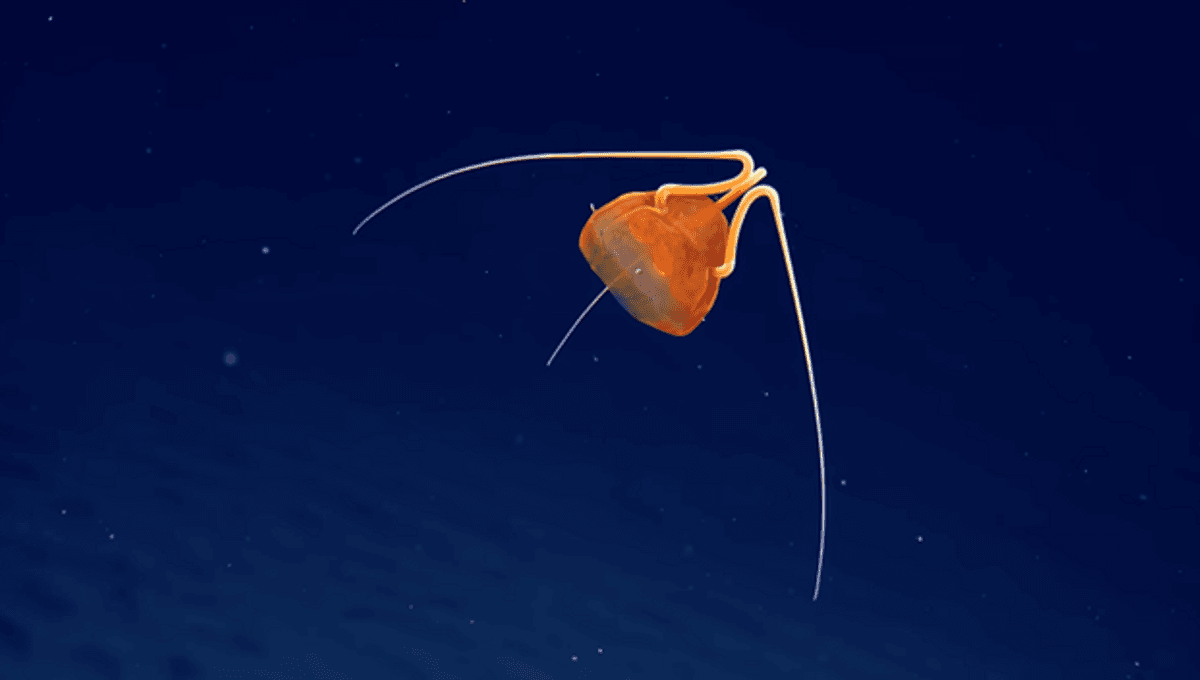
For the first time, researchers have laid eyes upon a newly discovered species of “gelatinous predator” spotted in the light-deprived depths of the Pacific Ocean. Experts now believe this yet-to-be-described species of jellyfish may illuminate a deeper understanding of the enigmatic aquatic world from which it emerged.
Scientists filmed the gelatinous orange organism at a depth of over 1,400 meters (nearly 4,600 feet) in the Pacific Remote Islands Marine National Monument, one of the most pristine yet unexplored ecosystems of the Pacific Ocean.
“It’s a gelatinous predator,” Dhugal Lindsay, a research scientist with the Japan Agency for Marine-Earth Science and Technology, told IFLScience. “They’ve got to be eating something large and also gelatinous at that depth.”
But exactly what this deep-dwelling mystery jelly, which is likely an undescribed species within the Bathykorus genus, predates upon is yet to be revealed.
Light does not penetrate the ocean depths at which Bathykorus was observed. To compensate, many marine organisms bioluminesce through a light-producing chemical reaction within their body – and any organism that Bathykorus consumes is also likely to emit such light.
Using spread-out tentacles on top of its bell, experts believe that Bathykorus eats other gelatinous animals like jellyfish and swimming cucumbers, as well as bioluminescent prey.
Unlike its transparent cousins, Lindsay believes that this Bathykorus has evolved its brown-red pigmentation to block bioluminescent light from bioluminescent prey from being externally visible from the animal’s stomach, allowing unique protection from potential predators.
“There’s got to be food down there. Big food,” said Lindsay, who has been studying this genus in the Arctic and waters surrounding Japan.
“The red-brown pigment is a protoporphyrin (probably) which reacts with sunlight and becomes toxic to the animal. That means we can safely assume the species doesn’t migrate to the surface in daylight hours.”
With just three tentacles, the trimerous jellyfish is “extremely rare” and appears to be an adult characterized by three stomach pouches. Its closest relative was observed for the first and only time nearly a decade ago by the NOAA Ocean Exploration’s ship Okeanos Explorer in the same region.
Not only does this Bathykorus tell the beginning chapters of its own life story, but it portrays a now-unknown narrative of the chain of predation that occurs within this unique, understudied realm.
“Up until recently, jellyfish have been thought to be a trophic dead end. Nothing eats jellyfish because they’re mostly water and they sting an animal’s lips when eaten. But this Bathykorus has the brown pigmentation to protect them — to stop the bioluminescence from showing through their stomachs. Something is trying to eat them,” said Lindsay, adding that the specimen’s morphology is so unique it assuredly represents a new species.
In fact, this Bathykorus could represent an entire group of pigmented jellyfish waiting to be discovered.
“For all we know, Bathykorus might bioluminesce as well. It could be a different wavelength or a different way to bioluminesce that predators just can’t see. Who knows?” Lindsay told IFLScience.
E/V Nautilus is an exploration vessel managed by the Ocean Exploration Trust (OET). Scientists aboard the ship explore deep-sea geology and biology through remote-operated vehicles (ROV) equipped with high-definition cameras and LED lighting to survey areas where light doesn’t otherwise penetrate.
“Most of our ocean remains unmapped and unexplored”, said OET Chief Scientist Daniel Wagner in a statement. “Our expeditions seek to not only collect critical baseline information that address priority needs of the resource management and scientific community but also share that information with everyone via telepresence technology.”
Just as this anomalous deep-sea jelly appeared from the depths, it quickly made “a run for it” out of the camera frame – for now.
Source Link: Never-Before-Seen Species of “Gelatinous Predator” Discovered in Remote Pacific Ocean